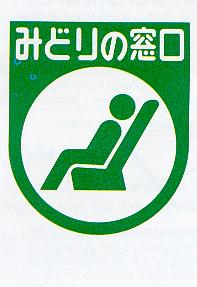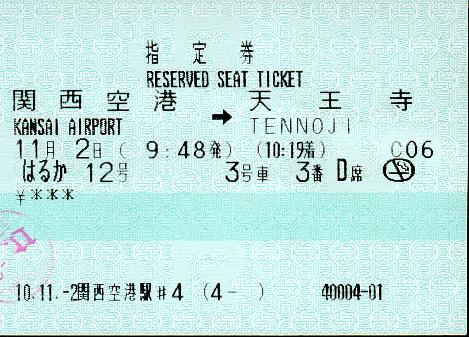| Howto for trains and buses The Rail Pass is not interesting in Shikoku |
Japan
Rail Pass
As all which needs space in Japan, train
is expensive. So, unless wanting only to stay in city, you
rather buy at
home, before leaving, Japan Rail Pass, who allows
you to take all the trains of JR (Japan Railways) during 1, 2 or 3
weeks for an all-inclusive price. The package for one
week corresponding to the price of a Tokyo / Osaka return ticket).
Japan rail pass
You can take the Pass in Ordinary class or Green (first
class), but the comfort of the common cars on main lines is equal to
the first class of the French T.G.V.
You can find this Japan Rail Pass in Japan Travel Bureau, by mail or at
your travel agency. You will receive then a voucher or "
Exchange order ", that you'll have to exchange at the arrival
to Japan in a station for the true Japan Rail Pass. You will receive
with your exchange order a list of stations making the
exchange , with a very clear plan to find the ticket
office.
Japan Rail Pass is valid at the
time
your exchange order. Caution, the first day
counts for a whole day and if you exchange a 7 days Pass
in the evening, you will get only the evening and 6 days.
Weigh up, please. If you plan to visit Kansai or Kyoto from Kansai
airport during 4 or 5 days and to make a tour of one week by train
afterward, he can be advantageous to go to Kyoto with a one-way ticket
and take an one-week Pass for the next week instead of a 2-weeks Pass
(you can change your voucher at Kyoto's station), or to visit Kansai
with a private line's "Kansai Thru Pass".
|
There is a more convenient card for Kansai (Airport, Osaka, Kyoto, Nara, Himeji, Koyasan) for all private trains (non JR). The private lines allow to approach closer to all the sightseeing sites than JR, because you also have free access to all Osaka, Kyoto, Kobe ... subways and buses for 2 or 3 days |
You can weigh up what is the best for you, looking at the train prices of the different lines on websites, but they are very sporadic, so try the following links to fine one in working order:
Hyperdia (the best, JR and private railways)
Travel
expert
Travel
calculator
How to use of the Japan Rail Pass



It is not valid
for private railroads, but these often
double the JR lines, on the same route. However, on certain
lines they are faster and more comfortable than the JR ( Nikko, Kyoto, Koyasan,
Ise).
|
Caution! Your japan Rail pass will NOT be renewed in case of loss or theftl |

Over the vending machines, you have a table representing the railroad lines with all the stops. In the big stations, there are often several companies of railway with identical vending machines, but grouped by company. Verify that you are on the good machine (JR, or Nankai, or Kintetsu...).


The two numbers in front of every name correspond to the kilometric basic price which you have to pay if you take a local or fast train, and at the price of the excess load to be added to this basic price to rise in a LEX or an express (in red over the basic price on our example).



" Adult 大人 おとな or Child 子供 こども ?",
" Ordinary or Green グリーン (1st Class)? ".
Introduce money or notes in the machine for at least the value which you have read on the table (basic rate + surcharge if necessary).
On modern
machines, the touches corresponding to the various prices
possible for the sum introduced are shining. Concretely
on the modern devices:
If
you want to go from Kyoto to Nara by the Kintetsu Express:
on the board of Kintetsu lines, you read for Nara 610/500 (610
of
the base and 500 of the surcharge), thus 1110 ¥. You
put one
1000 ¥ note and 2 100 ¥ coins = 1200
¥. The touches
which are going to shine will be (for example) 100, 130, 270, 450, 560,
710, 1110. You press on the touch "1110" and the machine prints you a
ticket and returns the change.
To reserve or to buy a ticket if you are lost in front of the boards, go to the ticket office indicated by a green panel "Green Counter"=Midori no madoguchi = みどり の 窓口 or "JR line's tickets" = Kip'pu uriba = きっぷうりば.


Show
your Rail Pass if you have it and give clearly your
destination.
|
« Tokyo
madé » = to Tokyo « Tokyo
yuki » = in the direction of Tokyo « hitori
dé » = one person
« futari dé » = 2
persons |
He will ask you « smoking or non
smoking? ».
All
the seats are put back in the direction of progress at the terminus.
The allocation of windows and corridors seems of the most unpredictable.
If you have no Rail Pass, you will pay in cash.
Then you have the ticket which contains the point and time of the departure , the point and time of the arrival , then the date, the name and the number of the train, the car, the row and the seat.

|
Kyoto
=> Nagoya (10:56)
departure (11:51) arrival 18/7
HIKARI 232
train n° 12 car n° 17 row C seat |

|
11月month 2日day Hikari 12 号number 3号車car number 3番row D席 seat |


|
«(Tokyo) yuki nan ban noriba? » = (Tokyo) direction which number platform? |
The
numbers of the cars are indicated on the ground and everybody stands in
the queue in order.
The train is often announced: " Ichi ban noriba " " Ni ban noriba " "
San ban noriba " " Yon ban noriba " = Platform number 1, 2,
3, 4
(literally 1, 2, 3, 4 Number Platform).

«
Train is arriving » :« Densha
ga kimasu » ou « Densha ga
mairimasu » like here above or in the loudspeaker.
The train will be exactly on time and right in front of you.
Watch
only not to rise in the train preceding yours, interval being often of
3 minutes in the big stations.
If you are travelling on the country, the train can be a "one man" train: wanman ワ ンマン. Or you will take a bus. Both have often the same system.
Get on the bus or the train (often through the rear door: 入口 IN, 出口 OUT. Take a ticket at the machine there. You will get a ticket with a number (see below "8") called 整理券 seiriken meaning the section where you got on the bus. You will find this number on the electric board above the driver, with the price you'll have to pay if you go down at the next station.
Price



The machine near the driver is a change machine, to get coins to pay the exact fare. Changing money during the trip of the bus is a national sport in Japan.
When you get your coins, you have not yet paid. You will pay when you get off the bus or the wanman : put the exact fare and the ticket with the number in the hole above the machine. The driver controls that you're paying the right sum.


